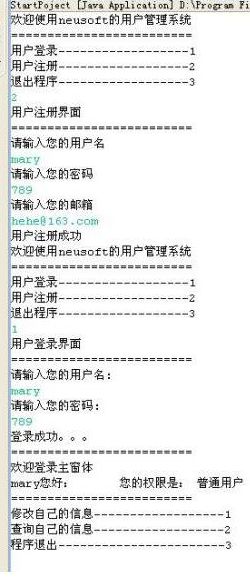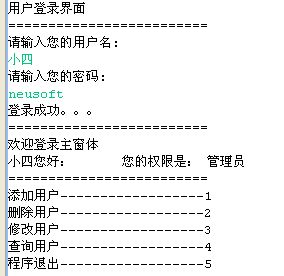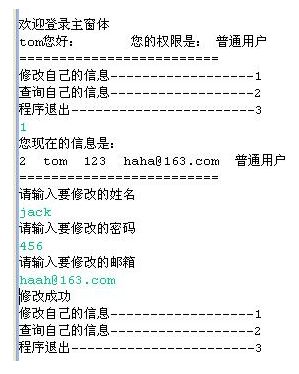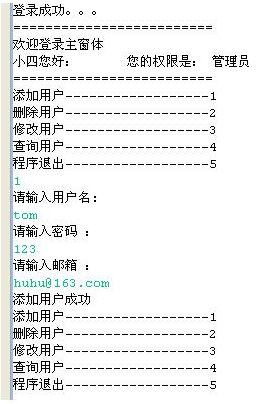2019.1.3 JDBC项目,项目名称 :用户管理系统
项目名称 :用户管理系统
开发环境 : 1. JDK 6.0
2. Eclipse 3.3或MyEclipse6.0
3. Oracle 10g
软件功能 :
- 注册功能: 用户可以注册成本软件的用户。(注:权限是 普通用户)
如下图:

. 登录功能: 用户输入用户名和密码。断用户是否存在
存在:提取用户的权限
权限如果是:管理员的话则显示如下图

权限如果是普通用户的话则显示如下图

3. 普通用户的修改功能
普通用户可以修改自己的name ,pass ,mail
不能修改权限和ID。
运行效果如下图:

4. 普通用户的查询功能
普通用户可以查询自己的详细信息
运行效果如下图:
5.管理员的添加功能
管理员的添加和普通用户的注册一样。Id自动分配。权限是普通用户:
运行效果如图:

-
管理员的修改功能:
管理员可以修改任何人的信息。(注:可以把普通用户修改成管理员)根据id 修改某个用户信息
运行效果如图:
-
管理员的查询功能:
管理员可以有三个查询方式:
运行效果如图: -
全部查询:
运行效果如图: -
根据id查询某一个用户:
运行效果如图: -
根据用户名查询:支持模糊查询
运行效果如图: -
管理员的删除功能:
运行效果如图:
User类
package com.neu.entity;
public class User {
private Integer id;
private String username;
private String password;
private String email;
private Integer role;
public User() {
super();
// TODO Auto-generated constructor stub
}
public User(Integer id, String username, String password, String email, Integer role) {
super();
this.id = id;
this.username = username;
this.password = password;
this.email = email;
this.role = role;
}
@Override
public String toString() {
return "User [id=" + id + ", username=" + username + ", password=" + password + ", email=" + email + ", role="
+ role + "]";
}
@Override
public int hashCode() {
final int prime = 31;
int result = 1;
result = prime * result + ((email == null) ? 0 : email.hashCode());
result = prime * result + ((id == null) ? 0 : id.hashCode());
result = prime * result + ((password == null) ? 0 : password.hashCode());
result = prime * result + ((role == null) ? 0 : role.hashCode());
result = prime * result + ((username == null) ? 0 : username.hashCode());
return result;
}
@Override
public boolean equals(Object obj) {
if (this == obj)
return true;
if (obj == null)
return false;
if (getClass() != obj.getClass())
return false;
User other = (User) obj;
if (email == null) {
if (other.email != null)
return false;
} else if (!email.equals(other.email))
return false;
if (id == null) {
if (other.id != null)
return false;
} else if (!id.equals(other.id))
return false;
if (password == null) {
if (other.password != null)
return false;
} else if (!password.equals(other.password))
return false;
if (role == null) {
if (other.role != null)
return false;
} else if (!role.equals(other.role))
return false;
if (username == null) {
if (other.username != null)
return false;
} else if (!username.equals(other.username))
return false;
return true;
}
public Integer getId() {
return id;
}
public void setId(Integer id) {
this.id = id;
}
public String getUsername() {
return username;
}
public void setUsername(String username) {
this.username = username;
}
public String getPassword() {
return password;
}
public void setPassword(String password) {
this.password = password;
}
public String getEmail() {
return email;
}
public void setEmail(String email) {
this.email = email;
}
public Integer getRole() {
return role;
}
public void setRole(Integer role) {
this.role = role;
}
public User(Integer id, String username, String password) {
super();
this.id = id;
this.username = username;
this.password = password;
}
public User(String username, String password, String email) {
super();
this.username = username;
this.password = password;
this.email = email;
}
}
UserDaoImpl类
package com.neu.dao;
import java.sql.Connection;
import java.sql.ResultSet;
import java.sql.SQLException;
import java.util.ArrayList;
import java.util.List;
import com.neu.entity.User;
public class UserDaoImpl {
//检验用户名密码是否正确,若正确,返回用户对象,不正确,返回null
public User login(String username,String password) throws SQLException {
String sql = "select * from myuser where username = ? and password = ? ";
Connection connection = JDBCUtil.getConnertion();
Object[] params = {username,password};
ResultSet rs = JDBCUtil.executeQuery(connection, sql, params);
User user = null;
if(rs.next()) {
int id = rs.getInt("id");
String email = rs.getString("email");
int role = rs.getInt("role");
user = new User(id,username,password,email,role);
}
rs.close();
JDBCUtil.closeConnection(connection);
return user;
}
//用户注册
public int insert(User user) throws SQLException {
String sql = "insert into myuser values(null,?,?,?,default)";
Object[] params = new Object[] {
user.getUsername(),
user.getPassword(),
user.getEmail()
};
int n = JDBCUtil.executeUpdate(sql, params);
return n;
}
//管理员查询全部用户
public ArrayList<User> getall() throws SQLException{
String sql = "select * from myuser order by id";
Connection connection = JDBCUtil.getConnertion();
ResultSet rs = JDBCUtil.executeQuery(connection, sql, null);
ArrayList<User> list = new ArrayList<>();
User user = null;
Integer id;
String username;
String password;
String email;
Integer role;
while(rs.next()) {
id = rs.getInt("id");
username = rs.getString("username");
password = rs.getString("password");
email = rs.getString("email");
role = rs.getInt("role");
user = new User(id,username,password,email,role);
list.add(user);
}
rs.close();
JDBCUtil.closeConnection(connection);
return list;
}
//按id查询
public User getById(int id) throws SQLException {
String sql = "select * from myuser where id = ?";
Connection connection = JDBCUtil.getConnertion();
ResultSet rs = JDBCUtil.executeQuery(connection, sql, new Object[] {id});
User user = null;
Integer id2;
String username;
String password;
String email;
Integer role;
while(rs.next()) {
id2 = rs.getInt("id");
username = rs.getString("username");
password = rs.getString("password");
email = rs.getString("email");
role = rs.getInt("role");
user = new User(id2,username,password,email,role);
}
rs.close();
JDBCUtil.closeConnection(connection);
return user;
}
//根据name查询
public User getName(String na) throws SQLException {
String sql = "select * from myuser where username like ?";
Connection connection = JDBCUtil.getConnertion();
ResultSet rs = JDBCUtil.executeQuery(connection, sql, new Object[] {"%"+na+"%"});
User user = null;
Integer id;
String username;
String password;
String email;
Integer role;
while(rs.next()) {
id = rs.getInt("id");
username = rs.getString("username");
password = rs.getString("password");
email = rs.getString("email");
role = rs.getInt("role");
user = new User(id,username,password,email,role);
}
rs.close();
JDBCUtil.closeConnection(connection);
return user;
}
//管理员修改用户
public int update(User user) throws SQLException {
String sql = "update myuser set username = ?,password = ?,email = ?,role = ? where id = ?";
Object[] params = new Object[] {
user.getUsername(),
user.getPassword(),
user.getEmail(),
user.getRole(),
user.getId()
};
int n = JDBCUtil.executeUpdate(sql, params);
return n;
}
//管理员删除用户
public int delete(int id) throws SQLException {
String sql = "delete from myuser where id = ?";
int n = JDBCUtil.executeUpdate(sql, new Object[] {id});
return n;
}
//普通用户修改
public int update2(User user2) throws SQLException {
String sql = "update myuser set username = ?,password = ?,email = ? where id = ?";
Object[] params = new Object[] {
user2.getUsername(),
user2.getPassword(),
user2.getEmail(),
user2.getId()
};
int n = JDBCUtil.executeUpdate(sql, params);
return n;
}
}
主界面类
package com.neu.ui;
import java.sql.SQLException;
import java.util.ArrayList;
import java.util.Scanner;
import javax.swing.plaf.synth.SynthOptionPaneUI;
import com.neu.dao.UserDaoImpl;
import com.neu.entity.User;
public class StartSystem {
static UserDaoImpl userDao = new UserDaoImpl();
static Scanner input = new Scanner(System.in);
public static void main(String[] args) throws SQLException {
boolean xx=true;
while(xx) {
System.out.println("欢迎使用neusoft的用户管理系统");
System.out.println("======================");
System.out.println("用户登录----------------1");
System.out.println("用户注册----------------2");
System.out.println("退出程序----------------3");
Scanner input=null;
int n=0;
try {
input = new Scanner(System.in);
n = input.nextInt();
} catch (Exception e) {
System.out.println("输入的值不是数字");
}
switch(n) {
case 1:
//如果方法写在这里不美观,代码量太大,用个方法写在下面
//用户登录
login();
continue;
case 2:
//用户注册
register();
continue;
case 3:
System.out.println("程序退出!");
xx=false;
break;
}
}
}
//用户登录
private static void login() throws SQLException {
System.out.println("请输入您的用户名:");
String username = input.next();
System.out.println("请输入您的密码:");
String password = input.next();
UserDaoImpl userDao = new UserDaoImpl();
User user = userDao.login(username, password);//判断用户是否正确
if(user != null) {
System.out.println("登录成功。。。");
System.out.println("======================");
System.out.println("欢迎登录主窗体");
System.out.println(username+"您好 "+"您的权限是:"+(user.getRole()==2?"管理员":"普通用户"));
System.out.println("======================");
if(user.getRole().equals(2)) {
boolean nn =true;
while(nn) {
System.out.println("添加用户---------------1");
System.out.println("删除用户---------------2");
System.out.println("修改用户---------------3");
System.out.println("查询用户---------------4");
System.out.println("程序退出---------------5");
int n = input.nextInt();
switch(n) {
case 1:
System.out.println("请输入用户名:");
String username1 = input.next();
System.out.println("请输入密码:");
String password1 = input.next();
System.out.println("请输入您的邮箱:");
String email = input.next();
User u = new User(null,username1,password1,email,null);
int n1 = userDao.insert(u);
if(n1 ==1) {
System.out.println("添加成功");
}else{
System.out.println("添加失败,用户已存在");
}
break;
case 2:
System.out.println("请输入需要删除的用户的ID号码:");
int n2 = input.nextInt();
userDao.delete(n2);
System.out.println("删除用户成功");
break;
case 3:
System.out.println("请输入要修改的用户的ID号码:");
int id = input.nextInt();
System.out.println("请输入要修改的用户的用户名:");
String username2 = input.next();
System.out.println("请输入要修改的用户的密码:");
String password2 = input.next();
System.out.println("请输入要修改的用户的邮箱:");
String email1 = input.next();
System.out.println("请输入要修改的用户的权限(管理员/普通用户):");
int role = input.nextInt();
User user1 = new User(id,username2,password2,email1,role);
int s =userDao.update(user1);
if(s == 1) {
System.out.println("修改成功");
}else{
System.out.println("修改失败");
}
break;
case 4:
System.out.println("查询全部用户------------1");
System.out.println("根据ID查询用户-----------2");
System.out.println("根据姓名查询用户-------------3");
System.out.println("请输入要做的操作");
int n3 = input.nextInt();
switch(n3) {
case 1:
ArrayList<User> list = new ArrayList<>();
list = userDao.getall();
for(User x :list) {
System.out.println(x.getId()+" "+x.getUsername()+" "+x.getPassword()+" "+x.getEmail()+" "+(x.getRole()==2?"管理员":"普通用户"));
System.out.println("======================");
}
break;
case 2:
System.out.println("请输入要查询的ID");
int n4 = input.nextInt();
User user2 =userDao.getById(n4);
System.out.println(user2.getId()+" "+user2.getUsername()+" "+user2.getPassword()+" "+user2.getEmail()+" "+(user2.getRole()==2?"管理员":"普通用户"));
System.out.println("======================");
break;
case 3:
System.out.println("请输入要查询的用户名(支持模糊查询)");
String n5 = input.next();
User user3 =userDao.getName(n5);
if(user3 != null) {
System.out.println(user3.getId()+" "+user3.getUsername()+" "+user3.getPassword()+" "+user3.getEmail()+" "+(user3.getRole()==2?"管理员":"普通用户"));
System.out.println("======================");
}else {System.out.println("此用户不存在");}
break;
}
break;
case 5:
System.out.println("程序退出");
nn = false;
break;
}
} //循环括号
}else {
boolean mm = true;
while(mm) {
System.out.println("======================");
System.out.println("修改自己的信息------------1");
System.out.println("查询自己的信息------------2");
System.out.println("程序退出----------------3");
int n = input.nextInt();
switch(n) {
case 1:
System.out.println("您现在的信息是:");
User user1 =userDao.getById(user.getId());
System.out.println(user1.getId()+" "+user1.getUsername()+" "+user1.getPassword()+" "+user1.getEmail()+" "+"普通用户");
System.out.println("======================");
System.out.println("请输入要修改的姓名");
String username1 = input.next();
System.out.println("请输入要修改的密码");
String password1 = input.next();
System.out.println("请输入要修改的邮箱");
String email = input.next();
User user2 = new User(user.getId(),username1,password1,email,null);
int s1 =userDao.update2(user2);
if(s1 == 1) {
System.out.println("修改成功");
}else{
System.out.println("修改失败");
}
break;
case 2:
User user3 =userDao.getById(user.getId());
System.out.println(user3.getId()+" "+user3.getUsername()+" "+user3.getPassword()+" "+user3.getEmail()+" "+(user3.getRole()==2?"管理员":"普通用户")); //多此一举
break;
case 3:
mm = false;
break;
}
}//循环括号
}
}
}
//用户注册
private static void register() throws SQLException{
System.out.println("请输入您的用户名:");
String username = input.next();
System.out.println("请输入您的密码:");
String password = input.next();
System.out.println("请输入您的邮箱:");
String email = input.next();
User u = new User(username,password,email);
int n = userDao.insert(u);
if(n == 1) {
System.out.println("注册成功");
}else {
System.out.println("失败");
}
}
}
UserDaoImpl类方法测试
package com.neu.test;
import java.util.List;
import java.sql.SQLException;
import java.util.ArrayList;
import org.junit.Test;
import com.neu.dao.UserDaoImpl;
import com.neu.entity.User;
public class UserDaoImplTest {
UserDaoImpl userDao = new UserDaoImpl();
@Test
public void testLogin() throws SQLException {
User user = userDao.login("tom","111");
System.out.println(user);
}
@Test
public void testinsert() throws SQLException {
User user= new User("marry","123","[email protected]");
int n =userDao.insert(user);
System.out.println(n);
}
@Test
public void testgetall() throws SQLException {
ArrayList<User> list = new ArrayList<>();
list = userDao.getall();
System.out.println(list);
}
@Test
public void testgetbyid() throws SQLException {
User user = new User();
user = userDao.getById(1);
System.out.println(user);
}
@Test
public void testgetname() throws SQLException {
User user = userDao.getName("tom");
System.out.println(user);
}
@Test
public void testupdate() throws SQLException {
User user = new User(4,"marry","456","321qq.com",2);
int n =userDao.update(user);
System.out.println(n);
}
@Test
public void testdelete() throws SQLException {
int n = userDao.delete(5);
System.out.println(n);
}
JDBCUitl类
package com.neu.dao;
import java.sql.Connection;
import java.sql.DriverManager;
import java.sql.PreparedStatement;
import java.sql.ResultSet;
import java.sql.SQLException;
public class JDBCUtil {
private static String driverClassName = "com.mysql.jdbc.Driver";
private static String url = "jdbc:mysql://localhost:3306/mydb";
private static String username = "root";
private static String password = "root";
//加载驱动
static {
try {
Class.forName(driverClassName);
} catch (ClassNotFoundException e) {
e.printStackTrace();
}
}
//得到连接
public static Connection getConnertion() throws SQLException{
Connection connection = DriverManager.getConnection(url, username, password);
return connection;
}
//关闭连接
public static void closeConnection(Connection connection) throws SQLException {
connection.close();
}
//执行增删改 操作
public static int executeUpdate(String sql,Object[] params) throws SQLException {
Connection connection = getConnertion();
PreparedStatement s = connection.prepareStatement(sql);
if(params != null) {
for(int i = 0; i< params.length;i++) {
s.setObject(i+1, params[i]);
}
}
int n = s.executeUpdate();
s.close();
connection.close();
return n;
}
//执行查询操作
public static ResultSet executeQuery(Connection connection,String sql,Object[] params) throws SQLException {
PreparedStatement s = connection.prepareStatement(sql);
if(params != null) {
for(int i = 0; i< params.length;i++) {
s.setObject(i+1, params[i]);
}
}
ResultSet rs = s.executeQuery();
return rs;
}
}